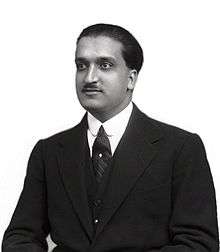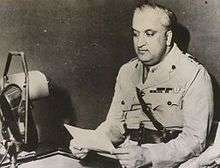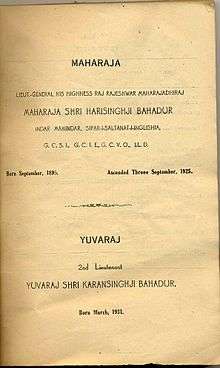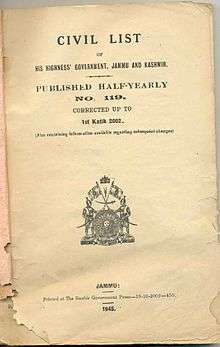Hari Singh
| Hari Singh हरि सिंह ਹਰਿ ਸਿੰਘ حری سنگه | |
|---|---|
| Maharaja of Jammu and Kashmir | |
 Hari Singh in 1944 | |
| Maharaja of Jammu and Kashmir | |
| Reign | 23 September 1925 — 26 April 1961 |
| Predecessor | Pratap Singh of Jammu and Kashmir |
| Successor | Monarchy Abolished (Karan Singh As Head of State) |
| Born |
23 September 1895 Jammu, Kashmir and Jammu, British Raj |
| Died |
26 April 1961 (aged 65) Bombay, Maharashtra, India |
| Spouse | Maharani Tara Devi (4th Wife) |
| Issue | Karan Singh |
| House | Royal House of Jammu and Kashmir |
| Father | Amar Singh |
| Religion | Sikhism |

Hari Singh (September 1895 – 26 April 1961) was the last ruling Maharaja of the princely state of Jammu and Kashmir in India.
He was married four times. With his fourth wife, Maharani Tara Devi (1910–1967), he had one son, Yuvraj (Crown Prince) Karan Singh.
Early life
Hari Singh was born on 23 September 1895 at the palace of Amar Mahal, Jammu, the only surviving son of General Raja Sir Amar Singh Jamwal (14 January 1864 – 26 March 1909), the brother of Maharaja Pratap Singh, the then Maharaja of Jammu and Kashmir.
Education and preparation for the throne
In 1903, Hari Singh served as a page of honour to Lord Curzon at the grand Delhi Durbar. At the age of thirteen, Hari Singh was dispatched to the Mayo College in Ajmer. A year later, in 1909, his father died, and the British took a keen interest in his education and appointed Major H. K. Brar as his guardian. After Mayo College, the ruler-in-waiting went to the British-run Imperial Cadet Corps at Dehra Dun for military training. By the age of twenty, he had been appointed as commander-in-chief of the state forces of Jammu and Kashmir.
Reign

Following the death of his uncle Maharaja Pratap Singh in 1925, Hari Singh ascended the throne of Jammu and Kashmir. He made primary education compulsory in the State, introduced laws prohibiting child marriage, and opened places of worship to the low castes.[1]
Singh was hostile towards the Indian National Congress, in part because of the close friendship between Kashmiri political activist and socialist Sheikh Abdullah and the Congress leader Jawaharlal Nehru. He also opposed the Muslim League and its members' communalist outlook, as represented by their two-nation theory. During the Second World War, from 1944–1946 Sir Hari Singh was a member of the Imperial War Cabinet.
In 1947, after India gained independence from British rule, Jammu and Kashmir had the option to join either India or Pakistan or to remain independent . Hari Singh originally maneuvered to maintain his independence by playing off India and Pakistan. There was a widespread belief that rulers of the princely states, in deciding to accede to India or Pakistan, should respect the wishes of the population, but few rulers took any steps to consult on such decisions. Jammu and Kashmir was a Muslim majority state, and Pashtun tribesmen from Pakistan invaded Jammu and Kashmir under the impression that Hari Singh would accede to India. Hari Singh appealed to India for help.[2] Although the Indian Prime Minister Nehru was ready to send troops, the Governor-General of India, Lord Mountbatten of Burma, advised the Maharaja to accede to India before India could send its troops. Hence, considering the emergency situation, the Maharaja signed an Instrument of Accession to the Dominion of India.
Hari Singh signed the Instrument of Accession on 26 October 1947, joining the whole of his princely state (including Jammu, Kashmir, Northern Areas, Ladakh, Trans-Karakoram Tract and Aksai Chin) to the Dominion of India.[3][4] These events triggered the first Indo-Pakistan War.
Pressure from Nehru and Sardar Patel eventually compelled Hari Singh to appoint his son and heir, Yuvraj (Crown Prince) Karan Singh, as Regent of Jammu and Kashmir in 1949, although he remained titular Maharaja of the state until 1952, when the monarchy was abolished. Karan Singh was appointed 'Sadr-e-Riyasat' ('President of the Province') in 1952 and Governor of the State in 1964.
Hari Singh spent his final days at the Hari Niwas Palace in Jammu. He diedon 26 April 1961 at Bombay. As per his will, his ashes were brought to Jammu and spread all over Jammu and Kashmir and immersed in the Tawi River at Jammu.[5]
Seal of Maharaja Hari Singh

The British Crown was at the top, representing the Emperor of India, whose Resident was posted in Kashmir. A katar or ceremonial dagger sat below the crown. Two soldiers held flags. An image of the sun was between them, that symbolised his Rajput lineage from Lord Surya, the Hindu Sun God.
Family
- Dharampur Rani Sri Lal Kunverba Sahiba; married at Rajkot 7 May 1913, died during pregnancy in 1915. No child.
- Chamba Rani Sahiba; married at Chamba 8 November 1915, died 31 January 1920. No child.
- Maharani Dhanvant Kunveri Baiji Sahiba (1910–19?); married at Dharampur 30 April 1923. No child.
- Maharani Tara Devi Sahiba of Kangra,(1910–1967); married 1928, separated 1950, one son:
- Yuvraj (Crown Prince), i.e., heir-apparent Karan Singh (9 March 1931–)
Titles


- 1895–1916: Sri Hari Singh
- 1916–1918: Raja Sri Hari Singh
- 1918–1922: Captain Raja Sir Hari Singh, KCIE
- 1922–1925: Captain Raja Sri Sir Hari Singh, KCIE, KCVO
- 1925–1926: Captain His Highness Shriman Rajrajeshwar Maharajadhiraj Sri Sir Hari Singh Indar Mahindar Bahadur, Sipar-i-Sultanat, Maharaja of Jammu and Kashmir, KCIE, KCVO
- 1926–1929: Colonel His Highness Shriman Rajrajeshwar Maharajadhiraj Sri Sir Hari Singh Indar Mahindar Bahadur, Sipar-i-Sultanat, Maharaja of Jammu and Kashmir, KCIE, KCVO
- 1929–1933: Colonel His Highness Shriman Rajrajeshwar Maharajadhiraj Sri Sir Hari Singh Indar Mahindar Bahadur, Sipar-i-Sultanat, Maharaja of Jammu and Kashmir, GCIE, KCVO
- 1933–1935: Colonel His Highness Shriman Rajrajeshwar Maharajadhiraj Sri Sir Hari Singh Indar Mahindar Bahadur, Sipar-i-Sultanat, Maharaja of Jammu and Kashmir, GCSI, GCIE, KCVO
- 1935–1941: Major-General His Highness Shriman Rajrajeshwar Maharajadhiraj Sri Sir Hari Singh Indar Mahindar Bahadur, Sipar-i-Sultanat, Maharaja of Jammu and Kashmir, GCSI, GCIE, KCVO
- 1941–1946: Lieutenant-General His Highness Shriman Rajrajeshwar Maharajadhiraj Sri Sir Hari Singh Indar Mahindar Bahadur, Sipar-i-Sultanat, Maharaja of Jammu and Kashmir, GCSI, GCIE, KCVO.
- 1946–1961: Lieutenant-General His Highness Shriman Rajrajeshwar Maharajadhiraj Sri Sir Hari Singh Indar Mahindar Bahadur, Sipar-i-Sultanat, Maharaja of Jammu and Kashmir, GCSI, GCIE, GCVO
Honours
(ribbon bar, as it would look today; incomplete)
![]()
![]()
![]()
![]()
![]()
![]()
![]()
![]()
![]()
![]()
![]()
![]()
![]()
![]()
- Delhi Durbar Medal-1903
- Delhi Durbar Medal-1911
- Prince of Wales Visit Medal-1922
- Knight Grand Commander of the Order of the Indian Empire (GCIE)-1929 (KCIE-1918)
- Grand Cross of the Order of the Crown of Italy-1930
- Knight Grand Commander of the Order of the Star of India (GCSI)-1933
- King George V Silver Jubilee Medal-1935
- King George VI Coronation Medal-1937
- Hon. LL.D from Punjab University-1938
- Grand Officer of the Legion d'Honneur-1938
- 1939-1945 Star-1945
- Africa Star-1945
- War Medal 1939-1945-1945
- India Service Medal-1945
- Knight Grand Cross of the Royal Victorian Order (GCVO)-1946 (KCVO-1922)
- Indian Independence Medal-1947
References
- ↑ ANAND, RAGHUBIR LAL (2014-02-01). IS God DEAD?????. Partridge Publishing. ISBN 9781482818239.
- ↑ Maharaja Hari Singh's Letter to Mountbatten
- ↑ Justice A. S. Anand, The Constitution of Jammu & Kashmir (5th edition, 2006), page 67
- ↑ Kashmir, Research Paper 04/28 by Paul Bowers, House of Commons Library, United Kingdom., page 46, 30 March 2004
- ↑ "J&K power defaulters cocking a snook at CM". Daily Pioneer. 18 January 2013. Retrieved 16 February 2013.
External links
| Wikimedia Commons has media related to Hari Singh. |
- 26 October 1947: Maharaja Hari Singh agrees to the accession of Jammu and Kashmir to India
- Genealogy of the ruling chiefs of Jammu and Kashmir
- Proclamation of 1 May 1951 on Jammu & Kashmir Constituent Assembly by Yuvraj (Crown Prince) Karan Singh (Son of Maharajah Hari Singh) from the Official website of Government of Jammu and Kashmir, India
- Conflict in Kashmir: Selected Internet Resources by the Library, University of California, Berkeley, USA; University of California at Berkeley Library Bibliographies and Web-Bibliographies list
- V Sundaram. "Salutations to Guruji Golwalkar – IV". Archived from the original on 4 December 2008. The role of Shri Guruji Golwalkar (Sarsanghchalak of the Rashtriya Swayamsevak Sangh – RSS)
- Nehru, Abdullah betrayed Maharaja Hari Singh
- Hari Singh's Blackmailing and Love In London
